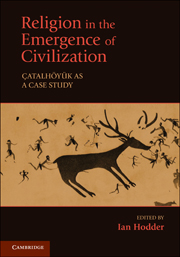Book contents
- Frontmatter
- Contents
- List of Figures and Tables
- Contributors
- 1 Probing religion at Çatalhöyük
- 2 The symbolism of Çatalhöyük in its regional context
- 3 Spiritual entanglement
- 4 Coding the nonvisible
- 5 Modes of religiosity at Çatalhöyük
- 6 Is there religion at Çatalhöyük…or are there just houses?
- 7 History houses
- 8 Marked, absent, habitual
- 9 Temporalities of “religion” at Çatalhöyük
- 10 The Neolithic cosmos of Çatalhöyük
- 11 Magical deposits at Çatalhöyük
- 12 Conclusions and evaluation
- Index
- References
7 - History houses
A new interpretation of architectural elaboration at Çatalhöyük
Published online by Cambridge University Press: 05 June 2012
- Frontmatter
- Contents
- List of Figures and Tables
- Contributors
- 1 Probing religion at Çatalhöyük
- 2 The symbolism of Çatalhöyük in its regional context
- 3 Spiritual entanglement
- 4 Coding the nonvisible
- 5 Modes of religiosity at Çatalhöyük
- 6 Is there religion at Çatalhöyük…or are there just houses?
- 7 History houses
- 8 Marked, absent, habitual
- 9 Temporalities of “religion” at Çatalhöyük
- 10 The Neolithic cosmos of Çatalhöyük
- 11 Magical deposits at Çatalhöyük
- 12 Conclusions and evaluation
- Index
- References
Summary
This chapter deals with building variation at Çatalhöyük. Such a theme is relevant to the discussion of religious ritual at the site because Mellaart initially interpreted architectural variation among buildings in terms of whether they were ‘shrines’. The work of the current project has demonstrated conclusively that all buildings at Çatalhöyük, however much burial, symbolism and ritual they contained, served as domestic houses. But Mellaart was right that some buildings seem more elaborate than others, even though the site as a whole is relatively egalitarian. How, then, are we to understand the more elaborate buildings, and how did they come into being? What social and religious roles did they play? This chapter explores, first, quantitative variation in the architecture at Çatalhöyük in the light of the results of recent work. It subsequently sets these findings about building variation in the context of a reinterpretation of more elaborated buildings as ‘history houses’. It focuses on Çatalhöyük itself and does not include comparisons and parallels with other sites. We acknowledge a debt to studies of the politics of tell house sequences through time in southeast Europe (see Tringham 2000; for a general review see McAnany and Hodder 2009).
The history of work on variation among buildings at Çatalhöyük includes Mellaart's (1967) identification of ‘shrines’ concentrated in a ‘priestly quarter’ in the southwest part of the East Mound. Others have focused on social differentiation (e.g., Wason 1994). Tim Ritchey (1996) showed that in terms of architectural elaboration (numbers of platforms, pillars, paintings, etc.) the buildings in any one occupation level showed a smooth and regular falloff when ranked from the most to the least elaborate. The very thorough and systematic work by Düring (2006) on the architectural elaboration of buildings excavated by Mellaart showed that elaborate buildings sometimes have a large number of burials, and they sometimes endure through several rebuilds. There has been little previous work on house size (although see in particular Cutting 2005) – perhaps because house size seems superficially to vary little.
- Type
- Chapter
- Information
- Religion in the Emergence of CivilizationÇatalhöyük as a Case Study, pp. 163 - 186Publisher: Cambridge University PressPrint publication year: 2010
References
- 61
- Cited by



